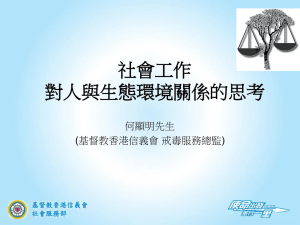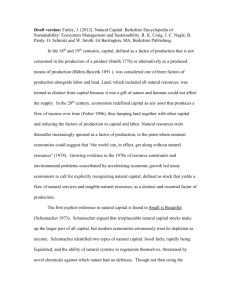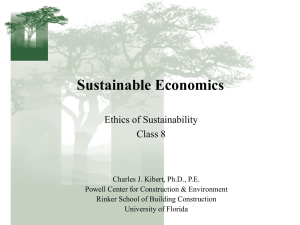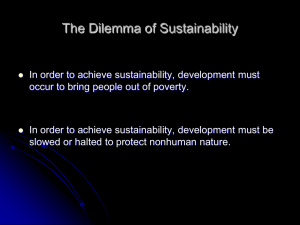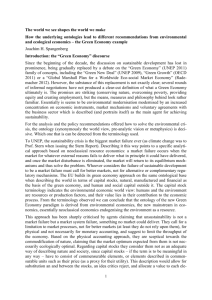Ecological Economics
advertisement
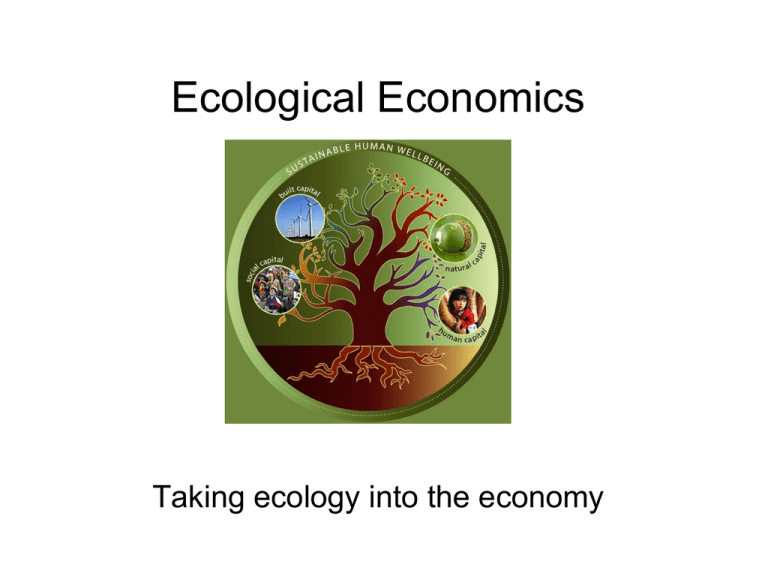
Ecological Economics Taking ecology into the economy Four ‘conditions of an imperilled environment’ Kirkpatrick Sale Drawdown: the process by which the dominant species in an ecosystem uses up the surrounding resources faster than they can be replaced. Overshoot: when the use of resources in an ecosystem exceeds its carrying capacity and there is no way to recover or replace what is lost. Crash: a precipitate decline in species numbers. Die-off: the extinction of species that cannot reorganize their ecological functioning following a crash. Ecological concepts applied to the economy Assimilative capacity: the capacity of the natural environment to absorb wastes Regenerative capacity: the ability of the ecosystem to replace resources that we use in our production systems Renewable resources, such as wood or wind energy, are in continuous supply, although the rate at which they can be replenished will vary from resource to resource Non-renewable resources, such as iron ore or fossil fuels, are in limited supply within the earth’s crust, and thus once they are used up they cannot be replaced. Problems Ecological Economists seek to resolve First, establish the ecological limits of sustainable scale and establish policies that assure that the throughput of the economy stays within these limits. Second, establish a fair and just distribution of resources using systems of property rights and transfers. . . Third, once the scale and distribution problems are solved, market-based mechanisms can be used to allocate resources efficiently. Introduction to Ecological Economics Costanza et al. (1997: 83) Watershed topics The concept of human behaviour that each embodies: whether the economic actor is a ‘rational economic man’ or a person who lives in balance with the environment; The way in which nature itself is valued, whether in monetary or biophysical terms; Judgements about the relationship between sustainable development and growth; The extent to which economics should be considered as a scientific study; Differing emphasis on issues of distribution and justice. The birth of a discipline Founded in the late 1980s Launch of the journal Ecological Economics in 1987 US and European have different emphasis Scathing about neoclassical economics: "The individualism of current economic theory is manifest in the purely self-interested behavior it generally assumes. It has no real place for fairness, malevolence, and benevolence, nor for the preservation of human life or any other moral concern.“ Herman Daly Herman Daly "The economy is a wholly owned subsidiary of the environment, not the reverse." Professor at the University of Maryland Senior Economist in the Environment Department of the World Bank Developed the concept of ‘sustainable development’ and also that of ‘uneconomic growth’ Uneconomic growth; cf. John Ruskin’s ‘illth’ Most neoclassical economists assume that technological advance will outpace resource scarcity over the long run and that ecological services can also be replaced by new technologies. Ecological economists, on the other hand, assume that resource and ecological limits are critically important and are much less confident that technological advances will arise in response to higher prices generated by scarcities. This difference in worldview, however, does not prevent neoclassical and ecological economists from sharing the same pattern of reasoning. (Costanza et al., 1997: 69). The Vision of Ecological Economics The earth as a closed system: limits to material and energy throughputs and wastes A future of material well-being with ourselves and other species while respecting the first point Systems are complex and causal pathways uncertain, hence the need for a precautionary approach Institutions should be proactive and should respond in spite of scientific uncertainties A different definition of sustainability Neoclassical environmental economists favour a goal of weak sustainability (technology will lead to physical capital substituting for natural capital) and sought to adopt an objective stance. Ecological economists favour a goal of strong sustainability (physical capital cannot substitute for natural capital) and are less concerned to prevent their personal viewpoint from impinging on their analysis. Comparing weak and strong sustainability Weak sustainability: environmental sustainability should be balanced with the need to continue economic growth Weak sustainability assumes that different forms of capital are substitutable with one another, therefore sustainability is achieved even if all natural capital is replaced with man-made capital Strong sustainability considers natural capital to be primary and sacrosanct Behind the notion of capitalism lies the notion of capital – which economists use to describe a stock of anything (physical or virtual) from which anyone can extract a revenue or yield. . . . (as in any stock capable of generating a flow). . . The Five Capitals Framework requires a more holistic understanding of all the different stocks of capital on which our wealth depends . . . Sustainability can only be achieved if these stocks of capital are kept intact or increased over time. (Porritt, 2009: 30-1). Five Capitals Framework We are facing a sustainability crisis because we're consuming our stocks of natural, human and social capital faster than they are being produced. Unless we control the rate of this consumption, we can't sustain these vital stocks in the long-term. Forum for the Future Natural capital Any stock or flow of energy and material that produces goods and services. It includes: Resources - renewable and non-renewable materials Sinks - that absorb, neutralise or recycle wastes Processes - such as climate regulation Natural capital is the basis not only of production but of life itself! Human and social capital Human Capital consists of people's health, knowledge, skills and motivation. All these things are needed for productive work. Enhancing human capital through education and training is central to a flourishing economy. Social Capital concerns the institutions that help us maintain and develop human capital in partnership with others; e.g. families, communities, businesses, trade unions, schools, and voluntary organisations. Manufactured and financial capital Manufactured Capital comprises material goods or fixed assets which contribute to the production process rather than being the output itself – e.g. tools, machines and buildings. Financial Capital plays an important role in our economy, enabling the other types of Capital to be owned and traded. But unlike the other types, it has no real value itself but is representative of natural, human, social or manufactured capital; e.g. shares, bonds or banknotes. Problems . . . Once capital is allowed to exist as a real entity in the economy, rather than as what Marx called an ‘epiphenomenon’, i.e. something that is superficial to the real machinery of the economy, it becomes possible to argue both that we can substitute one form of capital for another, and that we can substitute consumption in one time-period for consumption in another A Post-Normal Science? Does economics rely on the methods of science or are norms, values and morals automatically involved? • Popper’s falsifiability criterion • Impossibility of experimental method • Difficulties with measurement • Importance of assumptions Rational Economic Man? Individualist motivation Rational decision-making Clear definition of ‘utility’ Biologically determined, or culturally relative? Is there a gender dimension?

